9 Shocking Snake Bite Stories
Nathan Johnson
Published
11/23/2015
interesting
- List View
- Player View
- Grid View
Advertisement
-
1.
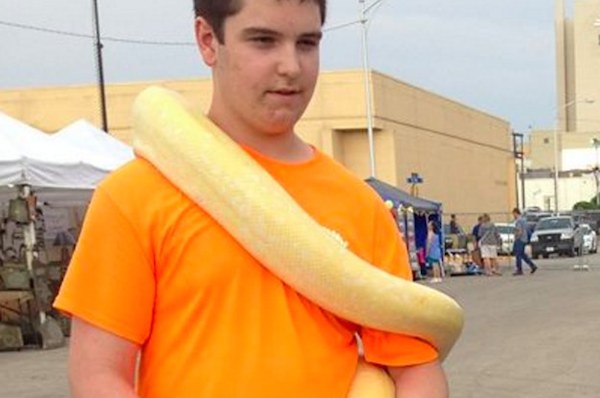 In July 2015, a Texas teenager found dead in his vehicle outside a Lowe's parking lot in Austin, Texas committed suicide—by cobra. Grant Thompson, 18, apparently allowed the snake to bite him repeatedly, causing his death. A later autopsy revealed no evidence that Thompson tried to stop the snake from biting him or get away from it. Death reportedly occurred within about thirty minutes, due to paralysis and respiratory failure caused by the snake's venom. Thompson had “several bites” on his arms, the autopsy revealed. The medical examiner's report stated that the bites “appeared to be intentional injection sites.” The report also states that Thompson had a history of “suicidal ideation.” Thompson worked at his family's pet shop in Temple, Texas. He was said to be a reptile lover. When his body was found at the Lowe's in Austin, his door was open and the cobra was missing from its container. It was later found dead on a nearby road after having been run over by a car.
In July 2015, a Texas teenager found dead in his vehicle outside a Lowe's parking lot in Austin, Texas committed suicide—by cobra. Grant Thompson, 18, apparently allowed the snake to bite him repeatedly, causing his death. A later autopsy revealed no evidence that Thompson tried to stop the snake from biting him or get away from it. Death reportedly occurred within about thirty minutes, due to paralysis and respiratory failure caused by the snake's venom. Thompson had “several bites” on his arms, the autopsy revealed. The medical examiner's report stated that the bites “appeared to be intentional injection sites.” The report also states that Thompson had a history of “suicidal ideation.” Thompson worked at his family's pet shop in Temple, Texas. He was said to be a reptile lover. When his body was found at the Lowe's in Austin, his door was open and the cobra was missing from its container. It was later found dead on a nearby road after having been run over by a car. -
2.
 It's long been thought—and taught—that Cleopatra was killed by a snake bite. But academics have now dismissed the popular view, saying venomous snakes (such as cobras or vipers) would have been too large to sneak unseen into the palace. Ancient accounts tell of a snake that was hidden inside a basket of figs brought in from the countryside and was used by the Eygyptian queen to commit suicide on August 12, 30 BC. It also allegedly killed two of her servants. Andrew Gray, curator of Herpetology at Manchester Museum, believes cobras, which can grow up to eight feet long, were too big to hide easily. And even if the snake was slightly smaller, it would still have been hard to conceal. Also, it would have had too little time to kill two or three people without being detected. Gray said, "Not only are Cobras too big, but there's just a 10 per cent chance you would die from a snake bite—most bites are dry bites that don't inject venom." So, how did Cleopatra die? Recent studies suggests she may have died from a drug cocktail. If this was the case, whether it was self-administered or given to her by someone else may never be known.
It's long been thought—and taught—that Cleopatra was killed by a snake bite. But academics have now dismissed the popular view, saying venomous snakes (such as cobras or vipers) would have been too large to sneak unseen into the palace. Ancient accounts tell of a snake that was hidden inside a basket of figs brought in from the countryside and was used by the Eygyptian queen to commit suicide on August 12, 30 BC. It also allegedly killed two of her servants. Andrew Gray, curator of Herpetology at Manchester Museum, believes cobras, which can grow up to eight feet long, were too big to hide easily. And even if the snake was slightly smaller, it would still have been hard to conceal. Also, it would have had too little time to kill two or three people without being detected. Gray said, "Not only are Cobras too big, but there's just a 10 per cent chance you would die from a snake bite—most bites are dry bites that don't inject venom." So, how did Cleopatra die? Recent studies suggests she may have died from a drug cocktail. If this was the case, whether it was self-administered or given to her by someone else may never be known. -
3.
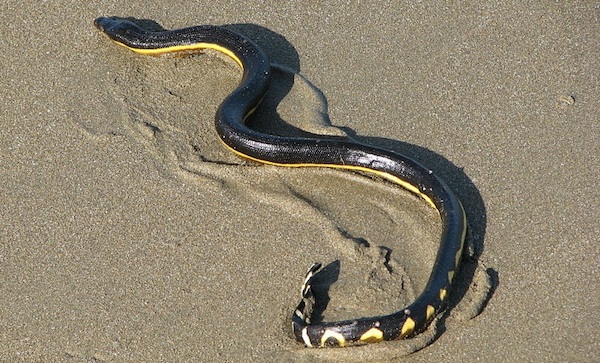 As if we don't have enough to worry about, El Niño is bringing more than just rain to California. A highly venomous sea snake was spotted in Ventura County in November 2015. Though uncommon to the West Coast of the U.S., yellow-bellied sea snakes can be found in many parts of the world. They are usually spotted in the water swimming next to floating debris or by coral reefs. They use their venom to paralyze their prey, which is typically small fish. The last sea snake species to be documented washed up on shore in 1972 in Orange County, which is about 100 miles south of Ventura County. Normally, yellow-bellied sea snakes are found in tropical waters closer to Baja, California and Central America. Warmer water temperatures are bringing more tropical species to California, including hammerhead sharks, tropical fish and sea snakes. Although venomous, Pauly said yellow-bellied sea snakes are generally harmless when left alone. Bites to humans normally occur when people try to handle the snakes.
As if we don't have enough to worry about, El Niño is bringing more than just rain to California. A highly venomous sea snake was spotted in Ventura County in November 2015. Though uncommon to the West Coast of the U.S., yellow-bellied sea snakes can be found in many parts of the world. They are usually spotted in the water swimming next to floating debris or by coral reefs. They use their venom to paralyze their prey, which is typically small fish. The last sea snake species to be documented washed up on shore in 1972 in Orange County, which is about 100 miles south of Ventura County. Normally, yellow-bellied sea snakes are found in tropical waters closer to Baja, California and Central America. Warmer water temperatures are bringing more tropical species to California, including hammerhead sharks, tropical fish and sea snakes. Although venomous, Pauly said yellow-bellied sea snakes are generally harmless when left alone. Bites to humans normally occur when people try to handle the snakes. -
4.
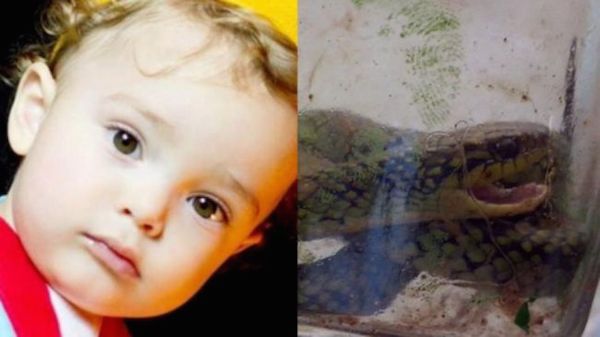 A 1-year-old Brazilian boy saved himself from a potentially venomous snake by killing it with a bite of his own. In November 2015, Jaine Ferreira went to check on her unusually quiet toddler Lorenzo at their home in Mostardas and discovered the toddler holding a snake in his mouth with blood on his hands and face. She said he was treating it as if it was one of his toys, and she and the boy's father had to wrestle the reptile out of his jaws. Doctors examined the boy and found no signs that he had been bitten by the snake, which he killed by biting down close to the animal's head and identified the snake as a venomous pit viper.
A 1-year-old Brazilian boy saved himself from a potentially venomous snake by killing it with a bite of his own. In November 2015, Jaine Ferreira went to check on her unusually quiet toddler Lorenzo at their home in Mostardas and discovered the toddler holding a snake in his mouth with blood on his hands and face. She said he was treating it as if it was one of his toys, and she and the boy's father had to wrestle the reptile out of his jaws. Doctors examined the boy and found no signs that he had been bitten by the snake, which he killed by biting down close to the animal's head and identified the snake as a venomous pit viper. -
5.
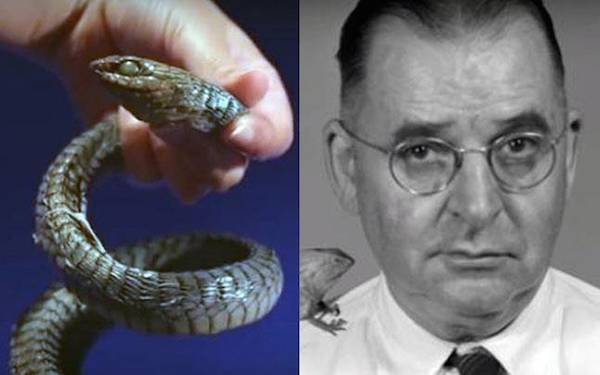 In 1957, herpetologist Karl P. Schmidt was working at the Chicago Natural History Museum and agreed to take a look at a snake brought in by the Lincoln Park Zoo. He immediately identified the snake as the highly venemous boomslang, and picked it up for closer examination. As he did, the reptile darted out and bit him on his left thumb, leaving two three-millimeter deep bloody puncture wounds. Instead of seeking further medical attention, he turned to his journal, and began recording the effects the venom was having on him: "4:30 - 5:30 PM strong nausea but without vomiting. During a trip to Homewood went on a suburban train. 5:30 - 6:30 PM strong chill and shaking followed by fever of 101.7. Bleeding of mucus membranes in the mouth began about 5:30, apparently mostly from gums. 8:30 PM ate two pieces of milk toast. 9:00 to 12:20 A.M. slept well. Urination at 12:20 AM mostly blood but a small amount. Took a glass of water at 4:30 AM, followed by violent nausea and vomiting, the contents of the stomach being the undigested supper. Felt much better and slept until 6:30 AM." After waking, Schmidt continued on with his morning as usual. He ate breakfast and continued recording his medical reactions to the venom in his journal — a curious scientist up until the very end. “September 26. 6:30 AM Temperature 98.2. Ate cereal and poached eggs on toast and apple sauce and coffee for breakfast. No urine with an ounce or so of blood about every three hours. Mouth and nose continuing to bleed, not excessively.” “Excessively” was the last word Schmidt entered in his diary. At about 1:30 p.m., he vomited and called his wife. By the time help arrived, he was unresponsive, covered in sweat, unable to talk. By 3 p.m. Schmidt was pronounced dead from “respiration paralysis.” Some believe Schmidt's death was a case of curiosity killing the scientist. Others, however, note that, being an expert herpetologist, Schmidt would have known that boomslang antivenom was available only in Africa.
In 1957, herpetologist Karl P. Schmidt was working at the Chicago Natural History Museum and agreed to take a look at a snake brought in by the Lincoln Park Zoo. He immediately identified the snake as the highly venemous boomslang, and picked it up for closer examination. As he did, the reptile darted out and bit him on his left thumb, leaving two three-millimeter deep bloody puncture wounds. Instead of seeking further medical attention, he turned to his journal, and began recording the effects the venom was having on him: "4:30 - 5:30 PM strong nausea but without vomiting. During a trip to Homewood went on a suburban train. 5:30 - 6:30 PM strong chill and shaking followed by fever of 101.7. Bleeding of mucus membranes in the mouth began about 5:30, apparently mostly from gums. 8:30 PM ate two pieces of milk toast. 9:00 to 12:20 A.M. slept well. Urination at 12:20 AM mostly blood but a small amount. Took a glass of water at 4:30 AM, followed by violent nausea and vomiting, the contents of the stomach being the undigested supper. Felt much better and slept until 6:30 AM." After waking, Schmidt continued on with his morning as usual. He ate breakfast and continued recording his medical reactions to the venom in his journal — a curious scientist up until the very end. “September 26. 6:30 AM Temperature 98.2. Ate cereal and poached eggs on toast and apple sauce and coffee for breakfast. No urine with an ounce or so of blood about every three hours. Mouth and nose continuing to bleed, not excessively.” “Excessively” was the last word Schmidt entered in his diary. At about 1:30 p.m., he vomited and called his wife. By the time help arrived, he was unresponsive, covered in sweat, unable to talk. By 3 p.m. Schmidt was pronounced dead from “respiration paralysis.” Some believe Schmidt's death was a case of curiosity killing the scientist. Others, however, note that, being an expert herpetologist, Schmidt would have known that boomslang antivenom was available only in Africa. -
6.
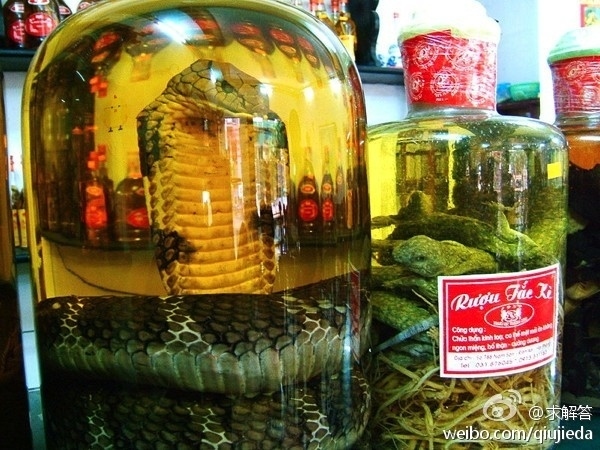 In 2013, a woman in China's Harbin City was bitten by a pit viper after marinating it in sorghum wine for three months. The woman, known as Ms. Liu, suffers from rheumatism and was given a live viper by her husband to brew in Chinese medicine at home. When she unsealed brew, she assumed it was dead, but it "woke up" and it bit her hand. Liu was sent to the hospital and treated with antibiotics. Doctors warn that snakes can lie dormant in liquor for months, or even years.
In 2013, a woman in China's Harbin City was bitten by a pit viper after marinating it in sorghum wine for three months. The woman, known as Ms. Liu, suffers from rheumatism and was given a live viper by her husband to brew in Chinese medicine at home. When she unsealed brew, she assumed it was dead, but it "woke up" and it bit her hand. Liu was sent to the hospital and treated with antibiotics. Doctors warn that snakes can lie dormant in liquor for months, or even years. -
7.
 In September 2014, Genise Ruidiaz, a contortionist and dancer, was slated to perform in Nicki Minaj's "Anaconda" routine at the VMAs while holding a live boa constrictor. However, the bit was scrapped before the show because the snake bit Ruidiaz during rehearsals. When a replacement snake was brought in, it bit its trainer while it was still wrapped around Ruidiaz. Ruidiaz said, "I was practicing the tricks with another contortionist and coming up with an alternate poses, and the snake was fine. We did it about four times. He was gripping me the way he was supposed to, but I felt like he was getting tired and didn't want to hold on much." "The trainers told me the only reason a snake would attack, is if they felt like they were at harm, so I tried to readjust to make sure that he felt safe on me. But right when I did one trick, I guess he must've felt I wasn't holding onto him, so he went ahead and took a nice little bite out of my left arm. He definitely had his mouth around my arm for a good 45 seconds, but to me it felt like an hour. It literally felt like getting a shot, but imagine 40 needles sticking you at once."
In September 2014, Genise Ruidiaz, a contortionist and dancer, was slated to perform in Nicki Minaj's "Anaconda" routine at the VMAs while holding a live boa constrictor. However, the bit was scrapped before the show because the snake bit Ruidiaz during rehearsals. When a replacement snake was brought in, it bit its trainer while it was still wrapped around Ruidiaz. Ruidiaz said, "I was practicing the tricks with another contortionist and coming up with an alternate poses, and the snake was fine. We did it about four times. He was gripping me the way he was supposed to, but I felt like he was getting tired and didn't want to hold on much." "The trainers told me the only reason a snake would attack, is if they felt like they were at harm, so I tried to readjust to make sure that he felt safe on me. But right when I did one trick, I guess he must've felt I wasn't holding onto him, so he went ahead and took a nice little bite out of my left arm. He definitely had his mouth around my arm for a good 45 seconds, but to me it felt like an hour. It literally felt like getting a shot, but imagine 40 needles sticking you at once." -
8.
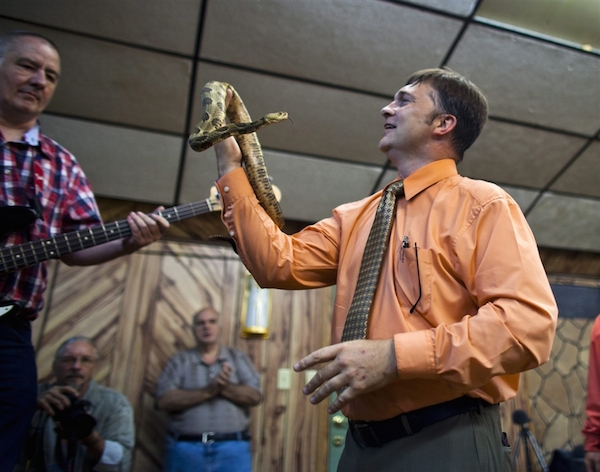 60-year-old John David Brock was bitten by a snake during during services at the Mossy Simpson Pentecostal Church in Jenson, Kentucky in July 2015. He refused medical treatment and soon died as a result of the venomous bite. Brock was an adherent to the Holiness faith. Some Holiness congregations handle snakes as part of their worship, and they do so by quoting a passage from the Book of Mark. (Mark 16:18 states, “(Believers) will pick up snakes with their hands; and when they drink deadly poison, it will not hurt them at all; they will place their hands on sick people, and they will get well.") Followers believe that God will stop the snakes from biting them, and if they do get bit, then God will save them from the poisonous effects of the venom. Despite being against the law, legal officials tend to look the other way. An estimated 300 churches still practice snake handling, and it's most common in Southern Appalachian states.
60-year-old John David Brock was bitten by a snake during during services at the Mossy Simpson Pentecostal Church in Jenson, Kentucky in July 2015. He refused medical treatment and soon died as a result of the venomous bite. Brock was an adherent to the Holiness faith. Some Holiness congregations handle snakes as part of their worship, and they do so by quoting a passage from the Book of Mark. (Mark 16:18 states, “(Believers) will pick up snakes with their hands; and when they drink deadly poison, it will not hurt them at all; they will place their hands on sick people, and they will get well.") Followers believe that God will stop the snakes from biting them, and if they do get bit, then God will save them from the poisonous effects of the venom. Despite being against the law, legal officials tend to look the other way. An estimated 300 churches still practice snake handling, and it's most common in Southern Appalachian states. -
9.
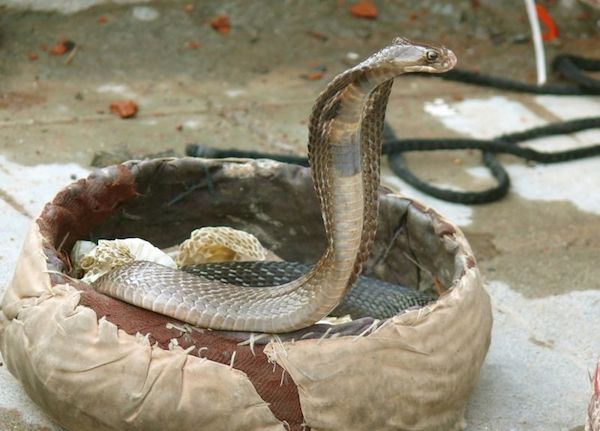 The January 2011 edition of the Substance Abuse journal covers snake bites as a novel form of addiction. Apparently people are purposely getting bitten by snakes to to get high. A team of researchers from Rachi, India recently released a report on two men who occasionally seek snake bites for their euphoric effect. It seems that bites from certain snakes (elapids and hydrophilids) can produce a toxic effect on nerve tissue and can cause symptoms that appeal to drug addicts and alcoholics.
The January 2011 edition of the Substance Abuse journal covers snake bites as a novel form of addiction. Apparently people are purposely getting bitten by snakes to to get high. A team of researchers from Rachi, India recently released a report on two men who occasionally seek snake bites for their euphoric effect. It seems that bites from certain snakes (elapids and hydrophilids) can produce a toxic effect on nerve tissue and can cause symptoms that appeal to drug addicts and alcoholics.
- REPLAY GALLERY
-

- 9 Shocking Snake Bite Stories
In July 2015, a Texas teenager found dead in his vehicle outside a Lowe's parking lot in Austin, Texas committed suicide—by cobra. Grant Thompson, 18, apparently allowed the snake to bite him repeatedly, causing his death. A later autopsy revealed no evidence that Thompson tried to stop the snake from biting him or get away from it. Death reportedly occurred within about thirty minutes, due to paralysis and respiratory failure caused by the snake's venom. Thompson had “several bites” on his arms, the autopsy revealed. The medical examiner's report stated that the bites “appeared to be intentional injection sites.” The report also states that Thompson had a history of “suicidal ideation.” Thompson worked at his family's pet shop in Temple, Texas. He was said to be a reptile lover. When his body was found at the Lowe's in Austin, his door was open and the cobra was missing from its container. It was later found dead on a nearby road after having been run over by a car.
9/9
1/9


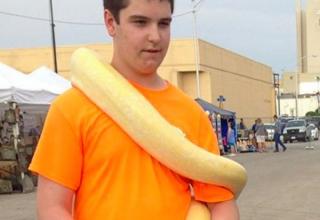




0 Comments